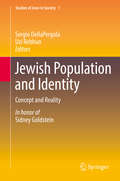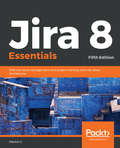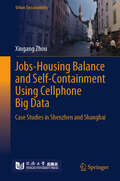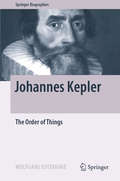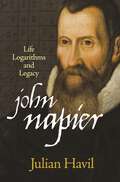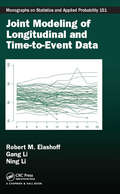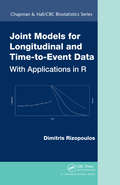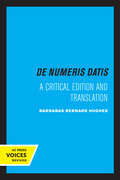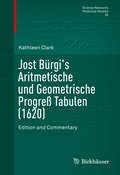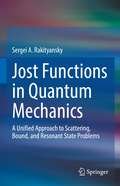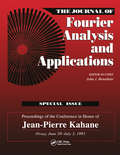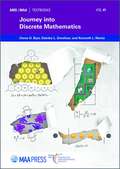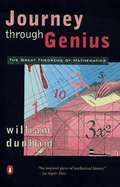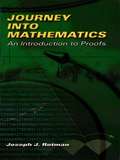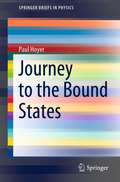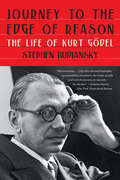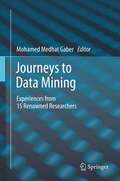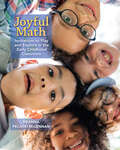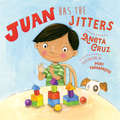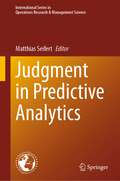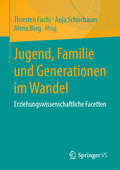- Table View
- List View
Jewish Family: Identity And Self-Formation At Home (The Modern Jewish Experience)
by Alex Pomson Randal F. SchnoorIn Jewish Family: Identity and Self-Formation at Home Alex Pomson and Randal F. Schnoor advance a new appreciation for the deep significance of Jewish family in developing Jewish identity. This book is the result of ten years of research focused on a small sample of diverse families. Through their work, the authors paint an intricate picture of the ecosystem that the family unit provides for identity formation over the life course. They draw upon theories of family development as well as sociological theories of the transmission of social and cultural capital in their analysis of the research. They find that family networks, which are often intergenerational, are just as significant as cultural capital, such as knowledge and competence in Judaism, to the formation of Jewish identity. Pomson and Schnoor provide readers with a unique view into the complexity of being Jewish in North America today.
Jewish Population and Identity: Concept and Reality (Studies of Jews in Society #1)
by Uzi Rebhun Sergio DellaPergolaThis book examines the fundamentals of Jewish demography and sociology around the world. It is not only concerned with documenting patterns of population change but also with an intriguing and ever-present issue like "Who is a Jew?" The latter transcends the limits of quantitative assessment and deeply delves into the nature, boundaries, and quality of group identification. A growing challenge is how to bridge between concept – related to ideals and theory – and reality – reflecting field research. Divided into six sections, the book discusses historical demography, immigration and settlement, population dynamics, social stratification and economy, family and Jewish identity in the U.S., and Jewish identity in Israel. The volume represents the dynamic and diverse nature of the study of world and local Jewish populations. It shows how that field of study provides an important contribution to the broader and now rapidly expanding study of religious and ethnic groups. Scholars in disciplines such as history, geography, sociology, economics, political science, and especially demography follow and analyze the social and cultural patterns of Jews in different places around the globe, at various times, and from complementary perspectives. They make use of historical sources that have recently become accessible, utilize new censuses and surveys, and adopt advanced analytical methods. While some of their observations attest to consistency in the Jews’ demographic and identificational patterns, others evolve and ramify in new directions that reflect general processes in the areas and societies that Jews inhabit, internal changes within Jewish communities, and intergenerational trends in personal preferences of religious and ethnic orientations. This volume brings together contributions from scholars around the world and presents new and updated research and insights.
Jira 8 Essentials - Fifth Edition: Effective Issue Management And Project Tracking With The Latest Jira Features, 5th Edition
by Patrick LiThis book will be especially useful for project managers but it's also intended for other Jira users, including developers, and any other industry besides software development, who would like to leverage Jira's powerful task management and workflow features to better manage their business processes.
Jobs-Housing Balance and Self-Containment Using Cellphone Big Data: Case Studies in Shenzhen and Shanghai (Urban Sustainability)
by Xingang ZhouThis book addresses the analysis of self-containment of employment (SCE), which measures journey-to-work trips among the percentage of workers who work locally. High SCE encourages the use of non-motorized transport and reduces transport-related energy consumption. In this book, mobile phone location data is employed to assess journey-to-work trips and explore spatial variations in SCE at multiple geographic scales. It finds that SCE is significantly higher in the suburbs than that in the central urban areas and tends to decrease as the spatial analysis unit shifts from the macro to the micro scale. The relationship between Jobs–housing balance is found to be more important in self-containment of employment for secondary-sector workers compared with that for tertiary-sector workers. Secondary-sector workers tend to reside near their workplaces because of relatively balanced jobs and housing, whereas tertiary-sector workers tend to reside farther away from their workplaces to save housing cost. A mixed-use index (MUI) in terms of employment is examined. The interconnections between MUI and SCE are examined in both industrial and commercial areas, to gauge the effect of the industrial-residential mix or commercial-residential mix on SCE. This book will enhance readers’ understanding of the spatial variations in SCE at multiple scales. In addition, its investigation of the effect of mixed use on SCE will shed new light on the relationship between land use and journey-to-work patterns.
Johannes Kepler: The Order of Things (Springer Biographies)
by Wolfgang OsterhageThis book traces the development of Kepler’s ideas along with his unsteady wanderings in a world dominated by religious turmoil. Johannes Kepler, like Galileo, was a supporter of the Copernican heliocentric world model. From an early stage, his principal objective was to discover “the world behind the world”, i.e. to identify the underlying order and the secrets that make the world function as it does: the hidden world harmony. Kepler was driven both by his religious belief and Greek mysticism, which he found in ancient mathematics. His urge to find a construct encompassing the harmony of every possible aspect of the world – including astronomy, geometry and music – is seen as a manifestation of a deep human desire to bring order to the apparent chaos surrounding our existence. This desire continues to this day as we search for a theory that will finally unify and harmonise the forces of nature.
John Napier: Life, Logarithms, and Legacy
by Julian HavilThe most comprehensive account of the mathematician's life and workJohn Napier (1550–1617) is celebrated today as the man who invented logarithms—an enormous intellectual achievement that would soon lead to the development of their mechanical equivalent in the slide rule: the two would serve humanity as the principal means of calculation until the mid-1970s. Yet, despite Napier's pioneering efforts, his life and work have not attracted detailed modern scrutiny. John Napier is the first contemporary biography to take an in-depth look at the multiple facets of Napier’s story: his privileged position as the eighth Laird of Merchiston and the son of influential Scottish landowners; his reputation as a magician who dabbled in alchemy; his interest in agriculture; his involvement with a notorious outlaw; his staunch anti-Catholic beliefs; his interactions with such peers as Henry Briggs, Johannes Kepler, and Tycho Brahe; and, most notably, his estimable mathematical legacy.Julian Havil explores Napier’s original development of logarithms, the motivations for his approach, and the reasons behind certain adjustments to them. Napier’s inventive mathematical ideas also include formulas for solving spherical triangles, "Napier’s Bones" (a more basic but extremely popular alternative device for calculation), and the use of decimal notation for fractions and binary arithmetic. Havil also considers Napier’s study of the Book of Revelation, which led to his prediction of the Apocalypse in his first book, A Plaine Discovery of the Whole Revelation of St. John—the work for which Napier believed he would be most remembered.John Napier assesses one man’s life and the lasting influence of his advancements on the mathematical sciences and beyond.
Joint Modeling of Longitudinal and Time-to-Event Data (Chapman & Hall/CRC Monographs on Statistics and Applied Probability #151)
by Ning Li Robert Elashoff Gang liLongitudinal studies often incur several problems that challenge standard statistical methods for data analysis. These problems include non-ignorable missing data in longitudinal measurements of one or more response variables, informative observation times of longitudinal data, and survival analysis with intermittently measured time-dependent covariates that are subject to measurement error and/or substantial biological variation. Joint modeling of longitudinal and time-to-event data has emerged as a novel approach to handle these issues. Joint Modeling of Longitudinal and Time-to-Event Data provides a systematic introduction and review of state-of-the-art statistical methodology in this active research field. The methods are illustrated by real data examples from a wide range of clinical research topics. A collection of data sets and software for practical implementation of the joint modeling methodologies are available through the book website. This book serves as a reference book for scientific investigators who need to analyze longitudinal and/or survival data, as well as researchers developing methodology in this field. It may also be used as a textbook for a graduate level course in biostatistics or statistics.
Joint Models for Longitudinal and Time-to-Event Data: With Applications in R (Chapman & Hall/CRC Biostatistics Series #Vol. 6)
by Dimitris RizopoulosIn longitudinal studies it is often of interest to investigate how a marker that is repeatedly measured in time is associated with a time to an event of interest, e.g., prostate cancer studies where longitudinal PSA level measurements are collected in conjunction with the time-to-recurrence. Joint Models for Longitudinal and Time-to-Event Data: Wit
Jordanus de Nemore, de Numeris Datis: A Critical Edition and Translation (Center for Medieval and Renaissance Studies, UCLA #14)
by Jordanus De NemoreThis title is part of UC Press's Voices Revived program, which commemorates University of California Press’s mission to seek out and cultivate the brightest minds and give them voice, reach, and impact. Drawing on a backlist dating to 1893, Voices Revived makes high-quality, peer-reviewed scholarship accessible once again using print-on-demand technology. This title was originally published in 1981.
Jost Bürgi's Aritmetische und Geometrische Progreß Tabulen
by Kathleen ClarkThis monograph presents a groundbreaking scholarly treatment of the German mathematician Jost Bürgi's original work on logarithms, Arithmetische und Geometrische Progreß Tabulen. It provides the first-ever English translation of Bürgi's text and illuminates his role in the development of the conception of logarithms, for which John Napier is traditionally given priority. High-resolution scans of each page of the his handwritten text are reproduced for the reader and as a means of preserving an important work for which there are very few surviving copies. The book begins with a brief biography of Bürgi to familiarize readers with his life and work, as well as to offer an historical context in which to explore his contributions. The second chapter then describes the extant copies of the Arithmetische und Geometrische Progreß Tabulen, with a detailed description of the copy that is the focus of this book, the 1620 "Graz manuscript". A complete facsimile of the text is included in the next chapter, along with a corresponding transcription and an English translation; a transcription of a second version of the manuscript (the "Gdansk manuscript") is included alongside that of the Graz edition so that readers can easily and closely examine the differences between the two. The final chapter considers two important questions about Bürgi's work, such as who was the copyist of the Graz manuscript and what the relationship is between the Graz and Gdansk versions. Appendices are also included that contain a timeline of Bürgi's life, the underlying concept of Napier's construction of logarithms, and scans of all 58 sheets of the tables from Bürgi's text. Anyone with an appreciation for the history of mathematics will find this book to be an insightful and interesting look at an important and often overlooked work. It will also be a valuable resource for undergraduates taking courses in the history of mathematics, researchers of the history of mathematics, and professors of mathematics education who wish to incorporate historical context into their teaching.
Jost Functions in Quantum Mechanics: A Unified Approach to Scattering, Bound, and Resonant State Problems
by Sergei A. RakityanskyBased on Jost function theory this book presents an approach useful for different types of quantum mechanical problems. These include the description of scattering, bound, and resonant states, in a unified way. The reader finds here all that is known about Jost functions as well as what is needed to fill the gap between the pure mathematical theory and numerical calculations. Some of the topics covered are: quantum resonances, Regge poles, multichannel scattering, Coulomb interaction, Riemann surfaces, multichannel analog of the effective range theory, one- and two-dimensional problems, many-body problems within the hyperspherical approach, just to mention few of them. These topics are relevant in the fields of quantum few-body theory, nuclear reactions, atomic collisions, and low-dimensional semiconductor nanostructures. In light of this, the book is meant for students, who study quantum mechanics, scattering theory, or nuclear reactions at the advanced level as well as for post-graduate students and researchers in the fields of nuclear and atomic physics. Many of the arguments that are traditional for textbooks on quantum mechanics and scattering theory, are covered here in a different way, using the Jost functions. This gives the reader a new insight into the subject, revealing new features of various mathematical objects and quantum phenomena.
Journal of Fourier Analysis and Applications Special Issue
by John J. BenedettoThe Journal of Fourier Analysis and Applications is a journal of the mathematical sciences devoted to Fourier analysis and its applications. The subject of Fourier analysis has had a major impact on the development of mathematics, on the understanding of many engineering and scientific phenomena, and on the solution of some of the most important problems in mathematics and the sciences. At the end of June 1993, a large Conference in Harmonic Analysis was held at the University of Paris-Sud at Orsay to celebrate the prominent role played by Jean-Pierre Kahane and his numerous achievements in this field. The large variety of topics discussed in this meeting, ranging from classical Harmonic Analysis to Probability Theory, reflects the intense mathematical curiosity and the broad mathematical interest of Jean-Pierre Kahane. Indeed, all of them are connected to his work. The mornings were devoted to plenary addresses while up to four parallel sessions took place in the afternoons. Altogether, there were about eighty speakers. This wide range of subjects appears in these proceedings which include thirty six articles.
Journal of Political Economy vol 128 no 9 (September 2020)
by The University of Chicago PressJournal of Political Economy vol 128 no 9 (September 2020)
Journey Into Discrete Mathematics (AMS/MAA Textbooks #41)
by Owen Byer Deirdre Smeltzer Kenneth WantzJourney into Discrete Mathematics is designed for use in a first course in mathematical abstraction for early-career undergraduate mathematics majors. The important ideas of discrete mathematics are included logic, sets, proof writing, relations, counting, number theory, and graph theory in a manner that promotes development of a mathematical mindset and prepares students for further study. While the treatment is designed to prepare the student reader for the mathematics major, the book remains attractive and appealing to students of computer science and other problem-solving disciplines. The exposition is exquisite and engaging and features detailed descriptions of the thought processes that one might follow to attack the problems of mathematics. The problems are appealing and vary widely in depth and difficulty. Careful design of the book helps the student reader learn to think like a mathematician through the exposition and the problems provided. Several of the core topics, including counting, number theory, and graph theory, are visited twice: once in an introductory manner and then again in a later chapter with more advanced concepts and with a deeper perspective. Owen D. Byer and Deirdre L. Smeltzer are both Professors of Mathematics at Eastern Mennonite University. Kenneth L. Wantz is Professor of Mathematics at Regent University. Collectively the authors have specialized expertise and research publications ranging widely over discrete mathematics and have over fifty semesters of combined experience in teaching this subject.
Journey Through Genius: The Great Theorems Of Mathematics
by William DunhamLike masterpieces of art, music, and literature, great mathematical theorems are creative milestones, works of genius destined to last forever. Now William Dunham gives them the attention they deserve. Dunham places each theorem within its historical context and explores the very human and often turbulent life of the creator -- from Archimedes, the absentminded theoretician whose absorption in his work often precluded eating or bathing, to Gerolamo Cardano, the sixteenth-century mathematician whose accomplishments flourished despite a bizarre array of misadventures, to the paranoid genius of modern times, Georg Cantor. He also provides step-by-step proofs for the theorems, each easily accessible to readers with no more than a knowledge of high school mathematics. A rare combination of the historical, biographical, and mathematical, Journey Through Genius is a fascinating introduction to a neglected field of human creativity.
Journey into Mathematics: An Introduction to Proofs (Dover Books on Mathematics)
by Joseph J. RotmanStudents learn how to read and write proofs by actually reading and writing them, asserts author Joseph J. Rotman, adding that merely reading about mathematics is no substitute for doing mathematics. In addition to teaching how to interpret and construct proofs, Professor Rotman's introductory text imparts other valuable mathematical tools and illustrates the intrinsic beauty and interest of mathematics.Journey into Mathematics offers a coherent story, with intriguing historical and etymological asides. The three-part treatment begins with the mechanics of writing proofs, including some very elementary mathematics--induction, binomial coefficients, and polygonal areas--that allow students to focus on the proofs without the distraction of absorbing unfamiliar ideas at the same time. Once they have acquired some geometric experience with the simpler classical notion of limit, they proceed to considerations of the area and circumference of circles. The text concludes with examinations of complex numbers and their application, via De Moivre's theorem, to real numbers.
Journey to the Bound States (SpringerBriefs in Physics)
by Paul HoyerThis book is a graduate-level self-study guide of bound states in elementary particle physics and consequently in the standard model. The author first recalls the usual quantum electrodynamics (QED) approach to atoms in terms of Feynman diagrams, which assume free states at asymptotic times. Motivated by general principles and data, he then develops a novel method based on a Fock expansion of bound states in temporal gauge. The properties of relativistic bound states are discussed for Dirac states, atoms in motion, QED in D=1+1 dimensions, and hadrons in quantum chromodynamics (including color confinement). This book provides complementary material for quantum field theory courses and is accessible for graduate students and more senior researchers.
Journey to the Edge of Reason: The Life Of Kurt Gödel
by Stephen BudianskyThe first major biography of the logician and mathematician whose Incompleteness Theorems helped launch a modern scientific revolution. Nearly a hundred years after its publication, Kurt Gödel’s famous proof that every mathematical system must contain propositions that are true—yet never provable—continues to unsettle mathematics, philosophy, and computer science. Yet unlike Einstein, with whom he formed a warm and abiding friendship, Gödel has long escaped all but the most casual scrutiny of his life. Stephen Budiansky’s Journey to the Edge of Reason is the first biography to fully draw upon Gödel’s voluminous letters and writings—including a never-before-transcribed shorthand diary of his most intimate thoughts—to explore Gödel’s profound intellectual friendships, his moving relationship with his mother, his troubled yet devoted marriage, and the debilitating bouts of paranoia that ultimately took his life. It also offers an intimate portrait of the scientific and intellectual circles in prewar Vienna, a haunting account of Gödel’s and Jewish intellectuals’ flight from Austria and Germany at the start of the Second World War, and a vivid re-creation of the early days of Princeton’s Institute for Advanced Study, where Gödel and Einstein both worked. Eloquent and insightful, Journey to the Edge of Reason is a fully realized portrait of the odd, brilliant, and tormented man who has been called the greatest logician since Aristotle, and illuminates the far-reaching implications of Gödel’s revolutionary ideas for philosophy, mathematics, artificial intelligence, and man’s place in the cosmos.
Journeys to Data Mining
by Mohamed Medhat GaberData mining, an interdisciplinary field combining methods from artificial intelligence, machine learning, statistics and database systems, has grown tremendously over the last 20 years and produced core results for applications like business intelligence, spatio-temporal data analysis, bioinformatics, and stream data processing. The fifteen contributors to this volume are successful and well-known data mining scientists and professionals. Although by no means an exhaustive list, all of them have helped the field to gain the reputation and importance it enjoys today, through the many valuable contributions they have made. Mohamed Medhat Gaber has asked them (and many others) to write down their journeys through the data mining field, trying to answer the following questions: 1. What are your motives for conducting research in the data mining field? 2. Describe the milestones of your research in this field. 3. What are your notable success stories? 4. How did you learn from your failures? 5. Have you encountered unexpected results? 6. What are the current research issues and challenges in your area? 7. Describe your research tools and techniques. 8. How would you advise a young researcher to make an impact? 9. What do you predict for the next two years in your area? 10. What are your expectations in the long term? In order to maintain the informal character of their contributions, they were given complete freedom as to how to organize their answers. This narrative presentation style provides PhD students and novices who are eager to find their way to successful research in data mining with valuable insights into career planning. In addition, everyone else interested in the history of computer science may be surprised about the stunning successes and possible failures computer science careers (still) have to offer.
Joyful Math: Invitations to Play and Explore in the Early Childhood Classroom
by Deanna Pecaski McLennanIf you've ever wished that learning math could be more joyful and playful for young learners, you're not alone. In Joyful Math: Invitations to Play and Explore in the Early Childhood Classroom, kindergarten teacher Deanna Pecaski McLennan opens her classroom doors to share the practical, yet innovative ways she integrates mathematical play throughout the school day. Each chapter of this easy-to-navigate, photo-filled book focuses on specific strategies, activities and examples of mathematical play within literacy, art, and outdoor explorations. Inside Joyful Mathyou'll find: A photo guide, including suggested tools and materials, to setting up a classroom environment and space that fosters mathematical curiosity and joyDozens of open-ended and teacher-guided mathematical activities that are simple to set up and full of mathematical possibilityPractical tips for including mathematical play across the daySuggestions and examples of ways to document and share children's learning experiences with families and communitiesJoyful Math will inspire educators to make space for joy and play in early childhood mathematics and give them the tools to make this vision a reality.
Joyful Mathematics class 1 - NCERT - 23
by National Council of Educational Research and TrainingThe book "Joyful Mathematics" for Class 1 is designed as an engaging and interactive introduction to foundational mathematical concepts for young learners, aligned with the National Education Policy 2020. The textbook emphasizes a play-based approach, integrating activities, games, and real-life contexts to make learning mathematics enjoyable and relevant. Each chapter focuses on building fundamental skills such as number recognition, counting, basic operations, and spatial understanding through hands-on activities and interactive discussions. The book also encourages the development of critical thinking, problem-solving, and environmental awareness, while promoting inclusivity and cultural rootedness. With a variety of illustrations, stories, and puzzles, the textbook aims to make mathematics a joyful and meaningful experience for children in their early years.
Joyful Mathematics class 2 - NCERT - 23
by National Council of Educational Research and TrainingIn the second grade NCERT math curriculum, students delve deeper into foundational mathematical concepts, building upon what they learned in the first grade. This level emphasizes developing a strong understanding of numbers, basic operations, and geometric shapes through interactive and engaging activities. A key focus of the curriculum is on strengthening the children's grasp of addition and subtraction. They learn to add and subtract numbers within 100 using various strategies such as counting on, making groups, and using number lines. Through practical exercises and real-life examples, students develop fluency in these fundamental operations, setting a solid mathematical foundation for future learning.
Juan Has the Jitters
by Aneta CruzA story about inclusion, diversity, and the power of math to help one boy with autism thrive among his peers.Juan claps his hands to get his Jitters out. They make his tummy swoosh and swirl. His Jitters happen when there are too many people, too much noise, or too many changes to his day. Juan doesn't like surprises.Tomorrow there is an athletic event planned at school, which makes Juan very nervous. But his teacher has the perfect solution: math--Juan's favorite subject! Counting, sorting, and matching help Juan calm his Jitters. By making math part of the day's athletic games, and by appointing Juan the official judge, his teacher can make sure that Juan will have fun and feel included. The class is calling it the Mathletic Games! Parents of children 4 to 8 years-old can use this book to help teach kids about neurodiversity, inclusion, and the beauty in what makes every one of us unique. Teachers will find the book meets several Common Core Standards for pre-K through third grade in reading and math, and nurtures multiple domains of scholastic development.
Judgment in Predictive Analytics (International Series in Operations Research & Management Science #343)
by Matthias SeifertThis book highlights research on the behavioral biases affecting judgmental accuracy in judgmental forecasting and showcases the state-of-the-art in judgment-based predictive analytics. In recent years, technological advancements have made it possible to use predictive analytics to exploit highly complex (big) data resources. Consequently, modern forecasting methodologies are based on sophisticated algorithms from the domain of machine learning and deep learning. However, research shows that in the majority of industry contexts, human judgment remains an indispensable component of the managerial forecasting process. This book discusses ways in which decision-makers can address human behavioral issues in judgmental forecasting. The book begins by introducing readers to the notion of human-machine interactions. This includes a look at the necessity of managerial judgment in situations where organizations commonly have algorithmic decision support models at their disposal. The remainder of the book is divided into three parts, with Part I focusing on the role of individual-level judgment in the design and utilization of algorithmic models. The respective chapters cover individual-level biases such as algorithm aversion, model selection criteria, model-judgment aggregation issues and implications for behavioral change. In turn, Part II addresses the role of collective judgments in predictive analytics. The chapters focus on issues related to talent spotting, performance-weighted aggregation, and the wisdom of timely crowds. Part III concludes the book by shedding light on the importance of contextual factors as critical determinants of forecasting performance. Its chapters discuss the usefulness of scenario analysis, the role of external factors in time series forecasting and introduce the idea of mindful organizing as an approach to creating more sustainable forecasting practices in organizations.
Jugend, Familie und Generationen im Wandel: Erziehungswissenschaftliche Facetten
by Alena Berg Thorsten Fuchs Anja SchierbaumJugend, Familie und Generationen sind durch einen fortschreitenden sozialen Wandel in allen Lebensbereichen charakterisiert. Eine Gesamtgestalt der vielgestaltigen Entwicklungen herauszuarbeiten, scheint kaum noch möglich. Im Zentrum des vorliegenden Bands steht daher die Erarbeitung von erziehungswissenschaftlichen Facetten. Die beteiligten Autorinnen und Autoren nehmen sich mit theoretisch-konzeptionellen Überlegungen und aktuellen Forschungsprojekten den Veränderungen (spät-)moderner Jugendwelten mitsamt den hierdurch hervortretenden wissenschaftlichen Herausforderungen an, diskutieren unterschiedliche Teilaspekte der Jugendforschung, reflektieren Konturen der Familienerziehung und setzen Stichworte um Generationenbeziehungen und -verhältnisse auf die Agenda. Die zusammengetragenen Befunde gleichen dabei dem Sehen mit einem Facettenauge, das – bestehend aus zahlreichen einzelnen Linsen – bei gleichbleibender Größe ein erstaunliches Gesamtbild zum Wandel von Jugend, Familie und Generationen liefert.

